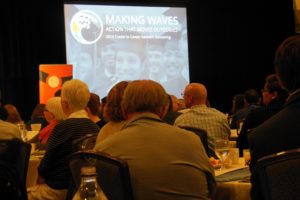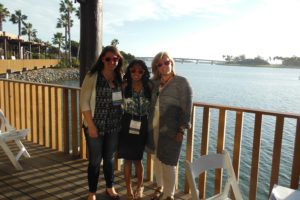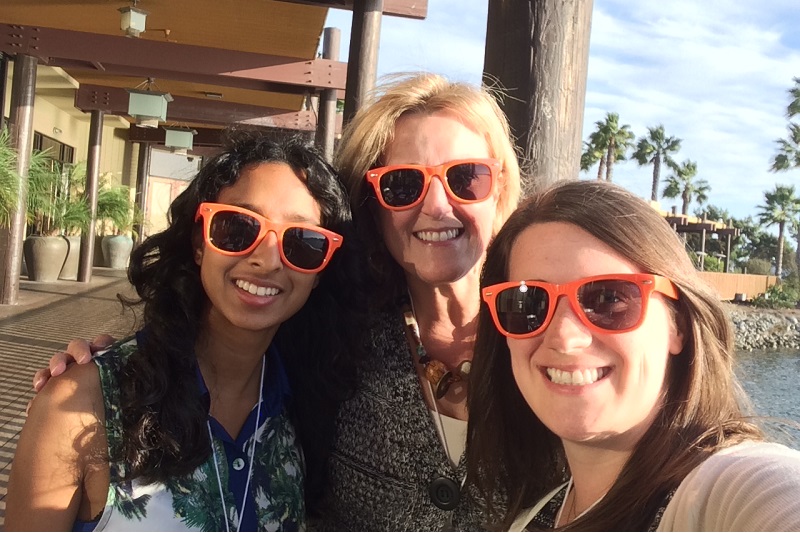Stephanie Cherrington, Kelly Jones, and Charlotte Anthony share their learnings from the StriveTogether Conference.
Making Waves
Stephanie Cherrington, executive director at Eastside Pathways
 The theme of this year’s StriveTogether National convening, making waves, reminded me that the waters that we chart in collective impact are anything but smooth. We seem to live in disequilibrium. This is not, of course, a comfortable state but rather one in which we are constantly challenged.
The theme of this year’s StriveTogether National convening, making waves, reminded me that the waters that we chart in collective impact are anything but smooth. We seem to live in disequilibrium. This is not, of course, a comfortable state but rather one in which we are constantly challenged.
Charting rough waters requires a strong constitution and a resilient team – think, “don’t toss your cookies and remain at your station.” The team should consist of those who are individually responsible for a specific role yet collectively move the ship in a forward direction. Undoubtedly, this is what the conference planning team had in mind when they came up with the name (minus the tossing cookies part).
One of the biggest takeaways from the conference for me was that I rarely met individuals from other backbone organizations. They were from people from school districts, public health, city offices, fire departments, and a plethora of different other organizations. Each person with very a different role from the other yet collectively had the same goal. In common, these were people who are taking an active role in charting the choppy waters of improving their community. They were there, interested in learning how to manage their individual roles so that collectively they can more effectively work on behalf of the kids.
It made me realize how much I wanted to share the experience of learning from others, with so many of you, our wonderful valued partners. How much I wanted to have conversations about what we had just heard from various speakers and how we could possibly do something like we’d just heard in Bellevue. I decided then and there, that next year I want to have a “team” of our partners at the conference learning to do this collective work better and better, together.
It also occurred to me that once we get better at doing this work together, we can concentrate more on the best outcomes for kids rather than how we’re actually working together. I have no doubt that we’ll always have to work on how we’re working together – it’s like a good marriage I suppose – but I also look forward to the day when we say to any newcomer to the area “this is just the way we chart the waters here in Bellevue.” We have our individual roles but collectively we’re moving forward.
How do you think we’re doing in charting the waters of collective impact?
What Can Ed Learn from Med?
Kelly Jones, data officer at Eastside Pathways
 Sometimes I daydream about what the world would look like if funding for children in need were unrestricted and infinite. If schools, community organizations, healthcare providers, and parents had access to a bottomless well of cash to spend on our children, would we be able to end educational inequity?
Sometimes I daydream about what the world would look like if funding for children in need were unrestricted and infinite. If schools, community organizations, healthcare providers, and parents had access to a bottomless well of cash to spend on our children, would we be able to end educational inequity?
As thought exercises go, this one is usually a dead end. It is so far-fetched that it’s hardly worth taking seriously. The lone insight it consistently yields is that more money would be helpful only to the extent that we know how to use it. To quote Kacey Guin, the director of continuous improvement for Seeding Success in Memphis and a presenter at the Strive convening, “More money is never the first right answer.”
The idea of continuous improvement, on the other hand, is absolutely worth taking seriously. Continuous improvement is central to the collective impact model. At the end of the day, if individuals and organizations are not doing something differently than we were before, outcomes for kids will not change.
Making a change that moves outcomes is easier said than done. It is often as difficult to pinpoint the effectiveness of current practices as it is to scale up those that are working—or, in the case of ineffective practices, to shut them down.
A key idea that stuck with me from the Strive convening is that there are probably already organizations in our community that do this well. They just may not be in education.
One speaker at the conference, Christopher Jordan from the Cincinnati Children’s Hospital Medical Center, shared his experience with quality improvement in the healthcare sector. The goal of their quality improvement process was to meet the needs and exceed the expectations of those they serve, which they do by rapid cycle testing, learning, and adaptation. To quote Jordan, “We want to become the best at getting better.”
I will be the first to acknowledge that education is not perfectly comparable to any other sector, medicine included. That said, the area of continuous improvement seems like an opportune place for organizations in other sectors such as business, healthcare, or manufacturing to plug in to the work of the partnership.
Who else should be at the table with us? Who has the expertise and capacity to support the Eastside Pathways partnership in this process? How can we do more of what works and less of what doesn’t?
Connecting the Right People to Create a Great Program
Charlotte Anthony, communications and admin associate at Eastside Pathways
 During the StriveTogether Conference in San Diego, we heard about a lot of great programs that other communities were working on.
During the StriveTogether Conference in San Diego, we heard about a lot of great programs that other communities were working on.
The ones that stood out to me were programs that encouraged peer-to-peer teaching such as when parents, instead of community organization representatives, were teaching parents about the skills that kids needed to get ready for kindergarten.
This program, along with the Early Warning Indicators program, are two examples from the City Heights Partnership in San Diego. The program essentially allows district officials to act faster with the data that they are already collecting.
Sandra McBrayer, the Chief Executive Officer of the Children’s Initiative, a San Diego-based child advocacy agency, explained that much of the work was outside of the scope of school officials. It was necessary to involve community partners. The agency connected the district with university students in social work programs who needed internship hours, along with the Health and Human Services Agency, who provided mentorship for the students.
The Early Warning Indicators program identifies students with two or more flags under these three categories. The first is attendance, which includes students with more than two absences, five tardies, or two truancies per month. The second is disciplinary indicators, including suspensions both in and out of school. The third is academic performance indicators, which include a GPA below 2.0.
Ron Rode, the executive director at San Diego Unified School District, explained that the “system is a flag so we know which students to address who need that extra support…it doesn’t mean that all students need the support but it allows us to go through and reach out to the students to find out what’s going on.”
Rode explained that the great thing about the system is that it uses live data and is filterable so it allows the school to see things in real time.
Patricia Leslie, the director of the Social Work Program at Point Loma Nazarene University, who helped connect interns to the program, explained that the interns are able to go through the list of students who are flagged and connect the students and families with resources at nearby organizations.
Leslie explained that it is important for the students to go to the organizations, meet the front desk person, see what the building looks like, and double check that they are accepting new clients.
“When interns go and meet with the locations, they have a sense of place so when they are speaking to a school staff or families, it helps to make the referral feel safer,” Leslie said.
After the session, I asked how much the program cost and was surprised to find out that the program was free but took a lot of coordination between the three players.
Towards the end of the session, someone commented that the program was a great example of collective impact because there will always be a university with students who need internship hours, and the district benefits from the extra help and targeted outreach and referrals.

